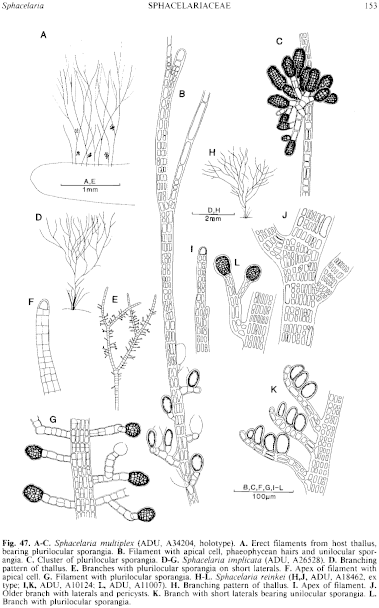|
|
|
|
|
|||||||||||
|
Electronic Flora of South Australia Species Fact Sheet
Phylum Phaeophyta – Order Sphacelariales – Family Sphacelariaceae
Selected citations: Lindauer et al. 1961: 156, fig. 12. Womersley 1967: 200.
Thallus (Fig. 47D) medium to dark brown, 5–10 mm long, densely tufted, epiphytic on Cystophora (e.g. C. monilifera), with numerous clumped basal axes just penetrating the host meristoderm and attached also by descending rhizoids. Branching (Fig. 47D) relatively sparse, alternate to subdichotomous with laterals at moderate to wide angles and equally developed to parent branches, with small conical apical cells (Fig. 47F) in mature branches; phaeophycean hairs absent or rare (Sauvageau 1901). Axes (Fig. 47E,G) 40–55 µm in diameter below, 30–40 µm in diameter above, segments L/B 0.5–1.0; secondary transverse walls frequent; pericysts conspicuous.
Reproduction: Reproduction by unilocular sporangia (Sauvageau 1901, fig. 27E) in adaxial rows of 4–5 on short laterals, ovoid, 35–45 µm long and 25–32 µm in diameter; and by ovoid plurilocular sporangia (Fig. 47G) usually 30–40 µm long and 20–30 µm in diameter, borne on the end of simple or branched laterals 3–6 cells long (Fig. 47E,G); these laterals arise from pericyst cells every few segments, occur at right angles to the branch, and are subdistichously arranged.
Lectotype from Banks Peninsula, New Zealand (Raoul); in PC.
Distribution: New Zealand.
In southern Australia, known from Aldinga, S. Aust., on Cystophora monthlera, drift (Womersley, 14.vii.1963; ADU, A26528) and possibly (sterile specimen) from off Troubridge Light, S. Aust., 17 m deep, on limestone (Shepherd, 4.ii.1969; ADU, A33409). The Robe, S. Aust. and Swansea, Tas. specimens in Womersley (1967, p. 200) are now referred to S. reinkei.
Taxonomic notes: The Aldinga collection agrees very well with Sauvageau's description and illustrations and bears abundant plurilocular sporangia.
References:
LINDAUER, V.W., CHAPMAN, V.J. & AIKEN, M. (1961). The marine algae of New Zealand. II. Phaeophyceae. Nova Hedwigia 3, 129–350, Plates 57–97.
WOMERSLEY, H.B.S. (1967). A critical survey of the marine algae of southern Australia. II. Phaeophyta. Aust. J. Bot. 15, 189–270.
The Marine Benthic Flora of Southern Australia Part II complete list of references.
Publication:
Womersley, H.B.S. (14 December, 1987)
The Marine Benthic Flora of Southern Australia
Part II
©Board of the Botanic Gardens and State Herbarium, Government of South Australia
Illustration in Womersley Part II, 1997: FIG 47 D–G.

Figure 47 enlarge
Fig. 47. A–C. Sphacelaria multiplex (ADU, A34204, holotype). A. Erect filaments from host thallus, bearing plurilocular sporangia. B. Filament with apical cell, phaeophycean hairs and unilocular sporangia. C. Cluster of plurilocular sporangia. D–G. Sphacelaria implicata (ADU, A26528). D. Branching pattern of thallus. E. Branches with plurilocular sporangia on short laterals. F. Apex of filament with apical cell. G. Filament with plurilocular sporangia. H–L. Sphacelaria reinkei (H,J, ADU, A18462, ex type; I,K, ADU, A10124; L, ADU, A11007). H. Branching pattern of thallus. I. Apex of filament. J. Older branch with laterals and pericysts. K. Branch with short laterals bearing unilocular sporangia. L. Branch with plurilocular sporangia.

|
Email Contact: State Herbarium of South Australia |

|